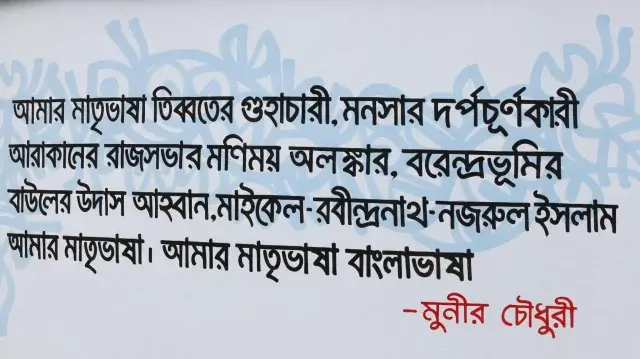The Bangla language, also known as Bengali, originates from the Indo-Aryan language family. It evolved from ancient Sanskrit and Prakrit languages, with influences from Persian, Arabic, and other regional languages, shaping its rich linguistic heritage.
Overview of the Bangla Language
The Bangla language, also known as Bengali, is an Indo-Aryan language primarily spoken in Bangladesh and the Indian state of West Bengal. It belongs to the eastern group of the Indo-Aryan languages. With over 230 million speakers worldwide, it ranks as the seventh most spoken language globally.
- Bangla is written using the Bengali script, which is an abugida script with 11 vowels and 39 consonants.
- The language has a rich literary tradition dating back to the 9th century, with prominent poets and writers such as Rabindranath Tagore and Kazi Nazrul Islam.
- Bangla has a unique honorific system wherein the second person pronouns change based on the speaker’s relationship with the listener.
- There are various dialects of Bangla spoken in different regions of Bangladesh and India, with slight variations in vocabulary and pronunciation.
Origins of the Bangla Language

The origins of the Bangla language can be traced back to the eastern regions of the Indian subcontinent, particularly the Bengal region. Here are some key points on the origins of Bangla:
1. Proto-Indo-European Roots:
- Bangla belongs to the Indo-Aryan language family, which traces its roots back to the Proto-Indo-European language spoken thousands of years ago.
2. Evolution from Magadhi Prakrit:
- The development of Bangla can be attributed to its evolution from the Magadhi Prakrit, a vernacular dialect derived from Sanskrit, spoken in the ancient kingdom of Magadha.
3. Influence of Sanskrit:
- Sanskrit, the ancient Indo-Aryan language, heavily influenced the vocabulary, grammar, and phonetics of Bangla, particularly during the early stages of its development.
4. Interactions with Pali and other Languages:
- Bangla also absorbed vocabulary and linguistic elements from Pali, an ancient Prakrit language used in Buddhist scriptures, as well as from other regional languages spoken in the Bengal region.
5. Emergence as a Distinct Language:
- Over time, Bangla emerged as a distinct language with its own grammar, syntax, and phonetic characteristics, separate from its Prakrit and Sanskrit roots.
6. Development of the Bengali Script:
- The Bengali script, derived from the Brahmi script, was developed to write the Bangla language, further solidifying its distinct identity.
7. Historical Context:
- The Bengal region has a rich history of cultural and linguistic exchange due to interactions with various empires and civilizations, including the Mauryas, Guptas, and Mughals, contributing to the development and enrichment of the Bangla language.
8. Literary Tradition:
- Bangla has a long literary tradition dating back to ancient times, with notable works such as the Charyapada, a collection of mystical poems from the 8th to 12th centuries, showcasing the early development of the language.
Linguistic Feature of the Bangla Language
The Bangla language is characterized by several distinctive linguistic features that contribute to its richness and complexity.
1. Subject-Object-Verb (SOV) Structure:
- Bangla follows an SOV sentence structure, where the subject typically precedes the object, and the verb comes at the end. For example, “Ami shobaike dekhi” (I see everyone).
2. Phonetics and Phonology:
- Bangla has a phonetic writing system, with each letter generally representing a single sound. It has a wide range of vowel and consonant sounds, including nasal vowels and retroflex consonants, contributing to its melodic quality.
3. Postpositions:
- Unlike English, which uses prepositions, Bangla employs postpositions. These are words that come after the noun or pronoun they modify. For example, “Ghar-e” (to the house).
4. Verb Conjugation:
- Bangla verbs are conjugated to indicate tense, aspect, mood, and agreement with the subject. Verbs can be conjugated for present, past, and future tenses, as well as for imperative and subjunctive moods.
5. Honorifics and Politeness:
- Bangla incorporates honorifics and polite forms of address to show respect or deference to others. Different forms of pronouns and verb conjugations are used depending on the level of formality and social hierarchy.
6. Compound Words:
- Bangla often forms compound words by combining two or more words to create new meanings. This feature allows for flexibility and creativity in expressing concepts and ideas.
7. Influence of Sanskrit and Persian:
- Bangla vocabulary has been enriched by borrowing words from Sanskrit, Persian, Arabic, and other languages over centuries of cultural exchange and contact. This linguistic diversity adds depth and nuance to the language.
Historical Context of the Bangla Language

The historical context of the Bangla language is deeply intertwined with the socio-political dynamics of the Bengal region, spanning centuries of cultural exchange, conquests, and interactions. Here is a summarized overview of the historical context of the Bangla language:
| Period | Key Events |
|---|---|
| Ancient Period | – Emergence of Magadhi Prakrit as a vernacular dialect. |
| – Influence of Sanskrit on language and literature. | |
| – Development of early Bengali literature (Charyapada). | |
| Medieval Period | – Arrival of Muslim rulers and Persian influence on language. |
| – Flourishing of Bengali literature (Mangalkavya, Padavali). | |
| – Incorporation of Arabic and Persian loanwords. | |
| Colonial Period | – British colonization and impact on education and administration. |
| – Introduction of printing press facilitates Bengali literature. | |
| – Emergence of modern Bangla prose and poetry. | |
| Modern Period | – Bengali Renaissance and cultural revival. |
| – Standardization of Bangla grammar and vocabulary. | |
| – Language movement for recognition of Bangla in East Pakistan. | |
| – Establishment of Bangla as an official language of Bangladesh. |
Emergence of Modern Bangla Language
The emergence of the modern Bangla language can be attributed to a series of socio-cultural and historical developments that took place during the late 19th and early 20th centuries.
- Colonial Influence: British colonization of the Indian subcontinent led to the introduction of Western education systems and the spread of printing press technology, which facilitated the dissemination of literature and ideas in Bangla.
- Bengali Renaissance: The Bengali Renaissance, a cultural and intellectual movement, sparked a renewed interest in Bangla language and literature. Prominent figures like Rabindranath Tagore and Bankim Chandra Chattopadhyay played significant roles in shaping the modern Bangla literary landscape.
- Literary Revival: The 19th century saw the emergence of modern Bangla prose and poetry, characterized by a departure from traditional styles and themes. This period witnessed experimentation with new literary forms and techniques.
- Standardization Efforts: Efforts to standardize Bangla grammar and vocabulary were undertaken by linguists and scholars, aiming to create a unified form of the language across different dialects.
- Nationalism and Language Movement: The language movement in East Bengal (now Bangladesh) during the mid-20th century played a crucial role in asserting the importance of Bangla as a national language and cultural identity, ultimately leading to its recognition as an official language of Bangladesh.
Standardization of Bangla Grammar and Vocabulary
The standardization of Bangla grammar and vocabulary was a significant step to create a unified and formalized form of the language.
- Linguistic Scholarship: Scholars like Ishwar Chandra Vidyasagar and Muhammad Shahidullah played crucial roles in studying and documenting various dialects of Bangla, identifying commonalities, and proposing standardization measures.
- Development of Grammar Rules: Based on linguistic analysis, grammar rules were formulated to govern the structure of sentences, verb conjugations, noun declensions, and other aspects of Bangla grammar.
- Vocabulary Standardization: Efforts were made to standardize Bangla vocabulary by selecting words from various dialects and linguistic sources, ensuring consistency and clarity in communication.
- Publication of Textbooks and Dictionaries: Textbooks and dictionaries were published to disseminate standardized grammar rules and vocabulary usage guidelines, aiding educators, writers, and language learners.
- Acceptance and Adoption: Over time, the standardized form of Bangla gained acceptance among speakers and writers, becoming the preferred mode of communication in formal settings, literature, and media.
Influence of Other Languages on Bangla
The Bangla language has been influenced by various languages throughout its history, enriching its vocabulary, phonology, and syntax. For example:
| Language | Influence on Bangla |
|---|---|
| Sanskrit | – Vocabulary enrichment through loanwords and roots. |
| – Influence on grammar, syntax, and literary styles. | |
| Persian | – Incorporation of Persian loanwords into Bangla. |
| – Influence on poetry, literature, and administration. | |
| Arabic | – Adoption of Arabic loanwords, particularly in religious contexts. |
| – Influence on Islamic religious texts and rituals. | |
| English | – Incorporation of English loanwords into modern Bangla. |
| – Influence on technical, scientific, and academic vocabulary. | |
| Portuguese | – Introduction of Portuguese loanwords during colonial period. |
| – Influence on maritime and trade-related terminology. | |
| Pali | – Borrowing of Buddhist religious vocabulary and concepts. |
| – Influence on early literature and cultural practices. |
Role of Bangla Language in Literature, Arts, and Music
The Bangla language plays a pivotal role in shaping the cultural landscape of the Bengal region, particularly in literature, arts, and music. Here’s an overview of its significance:
Literature:
- Bangla literature boasts a rich tradition dating back centuries, with renowned poets and writers like Rabindranath Tagore, Kazi Nazrul Islam, and Bankim Chandra Chattopadhyay.
- It encompasses various genres including poetry, novels, short stories, and plays, exploring diverse themes ranging from love and patriotism to social issues and spirituality.
- Bangla literature serves as a repository of Bengali identity and heritage, preserving language, history, and cultural values for future generations.
Arts:
- Bangla language is intertwined with various forms of visual arts such as painting, sculpture, and crafts, reflecting themes from mythology, folklore, and everyday life.
- Traditional art forms like Nakshi Kantha (embroidered quilts) and Patachitra (scroll painting) often incorporate Bangla calligraphy and storytelling.
Music:
- Bangla language is central to the vibrant music scene of Bengal, with genres like Rabindra Sangeet (songs by Rabindranath Tagore), Nazrul Geeti (songs by Kazi Nazrul Islam), and modern Bangla songs.
- Lyrics in Bangla often explore profound emotions and philosophical concepts, resonating deeply with listeners and serving as a vehicle for cultural expression and identity.
Conclusion
In conclusion, the Bangla language stands as a testament to the rich cultural heritage and historical evolution of the Bengal region. From its ancient origins rooted in Sanskrit and Prakrit to its modern-day significance as the official language of Bangladesh and the Indian state of West Bengal, Bangla has played a very important role in shaping the identity and expression of the Bengali people.
References:
https://lingo-star.com/bengali-language/
https://hindustanitongue.com/language-of-bengal-the-evolution-of-bengali-a-historical-journey/

